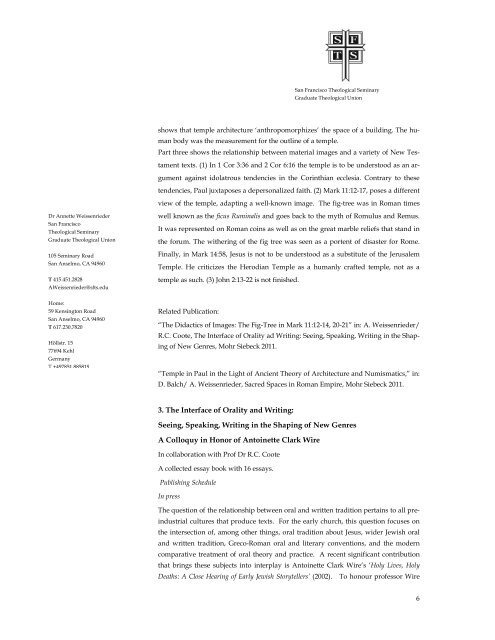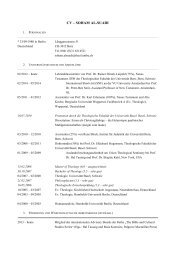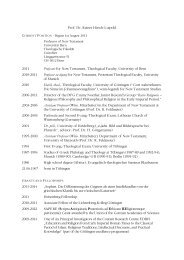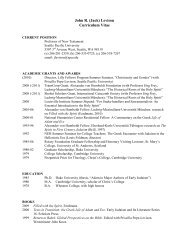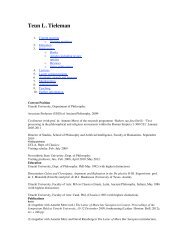Curriculum Vitae PDF - Early Christian Pneumatology
Curriculum Vitae PDF - Early Christian Pneumatology
Curriculum Vitae PDF - Early Christian Pneumatology
You also want an ePaper? Increase the reach of your titles
YUMPU automatically turns print PDFs into web optimized ePapers that Google loves.
Dr Annette Weissenrieder<br />
San Francisco<br />
Theological Seminary<br />
Graduate Theological Union<br />
105 Seminary Road<br />
San Anselmo, CA 94960<br />
T 415.451.2828<br />
AWeissenrieder@sfts.edu<br />
Home:<br />
59 Kensington Road<br />
San Anselmo, CA 94960<br />
T 617.230.7820<br />
Höllstr. 15<br />
77694 Kehl<br />
Germany<br />
T +497851.885819<br />
San Francisco Theological Seminary<br />
Graduate Theological Union<br />
shows that temple architecture ‘anthropomorphizes’ the space of a building. The hu-<br />
man body was the measurement for the outline of a temple.<br />
Part three shows the relationship between material images and a variety of New Tes-<br />
tament texts. (1) In 1 Cor 3:36 and 2 Cor 6:16 the temple is to be understood as an ar-<br />
gument against idolatrous tendencies in the Corinthian ecclesia. Contrary to these<br />
tendencies, Paul juxtaposes a depersonalized faith. (2) Mark 11:12-17, poses a different<br />
view of the temple, adapting a well-known image. The fig-tree was in Roman times<br />
well known as the ficus Ruminalis and goes back to the myth of Romulus and Remus.<br />
It was represented on Roman coins as well as on the great marble reliefs that stand in<br />
the forum. The withering of the fig tree was seen as a portent of disaster for Rome.<br />
Finally, in Mark 14:58, Jesus is not to be understood as a substitute of the Jerusalem<br />
Temple. He criticizes the Herodian Temple as a humanly crafted temple, not as a<br />
temple as such. (3) John 2:13-22 is not finished.<br />
Related Publication:<br />
“The Didactics of Images: The Fig-Tree in Mark 11:12-14, 20-21” in: A. Weissenrieder/<br />
R.C. Coote, The Interface of Orality ad Writing: Seeing, Speaking, Writing in the Shap-<br />
ing of New Genres, Mohr Siebeck 2011.<br />
“Temple in Paul in the Light of Ancient Theory of Architecture and Numismatics,” in:<br />
D. Balch/ A. Weissenrieder, Sacred Spaces in Roman Empire, Mohr Siebeck 2011.<br />
3. The Interface of Orality and Writing:<br />
Seeing, Speaking, Writing in the Shaping of New Genres<br />
A Colloquy in Honor of Antoinette Clark Wire<br />
In collaboration with Prof Dr R.C. Coote<br />
A collected essay book with 16 essays.<br />
Publishing Schedule<br />
In press<br />
The question of the relationship between oral and written tradition pertains to all pre-<br />
industrial cultures that produce texts. For the early church, this question focuses on<br />
the intersection of, among other things, oral tradition about Jesus, wider Jewish oral<br />
and written tradition, Greco-Roman oral and literary conventions, and the modern<br />
comparative treatment of oral theory and practice. A recent significant contribution<br />
that brings these subjects into interplay is Antoinette Clark Wire’s ‘Holy Lives, Holy<br />
Deaths: A Close Hearing of <strong>Early</strong> Jewish Storytellers’ (2002). To honour professor Wire<br />
6


